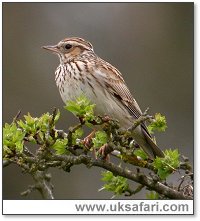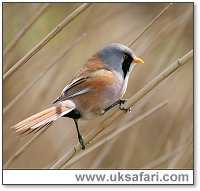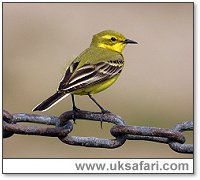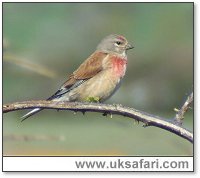
|

|
|
 Sent
to you Sent
to you
by e-mail
|
|
Simply
enter your details and hit the send button
more
info |
|


Click Here

Links
Advertise
Terms of Use
Contributors
About Us
Contact Us
|
 |
Go back
 | Bookmark
| Bookmark
 | Print Page
| Print Page  | E-Mail Us
| E-Mail Us 
Rare Bird Sightings
May 2006

Photo: Dean Eades
|
|
UK
Safari Tip:
Need help identifying birds? One of the best field guides is the
"Collins Bird Guide" - available through the Amazon bookshop -
click
here
|
|
This Woodlark was spotted at the end of April by Dean Eades in Lincolnshire.
Woodlarks are a red listed species because of recent declines in their
population. The RSPB estimate there are around 1,550 breeding pairs left.
Although it can be found in a number of areas in Britain, it is most frequently
seen in eastern and southern England. Places like; the New Forest, Hampshire,
Berkshire, Surrey, Breckland and Suffolk are the best
places to spot them.

Photo: Dean Eades
This Bearded Tit was photographed by Dean Eades on the coast at Lincolnshire.
There are only around 400 breeding pairs of Bearded Tits left in the UK, making
them an amber listed species.
We also received a report from Peter Mason in Nottingham on the 27th April of a
Citrine Wagtail. Peter spotted it in his garden close to the River Trent, and
said it was definitely not either a Yellow or Pied Wagtail as the intensity of the lemon colour
was so much brighter as to be dazzling. The entire head, neck and breast were lemon coloured with two prominent white wing bars.
Sadly he was unable to get a photo.

Photo: Dean Eades
Meanwhile in Nocton Fen, Lincolnshire, Dean Eades got this superb shot of a
Yellow Wagtail. These birds are summer visitors, spending the winter in Africa.
Yellow wagtails have been declining since at the 1980s, possibly due to loss of
breeding and feeding habitat. They are now an amber listed species.

Photo: Lesley Gadsden
This Linnet photo was sent in by Lesley Gadsden who spotted it in Dorset.
Although these birds can still be seen in most parts of the UK, like many other
farmland birds, their numbers are declining and they are now a Red listed
species.

Top 50 Garden Birds ID Chart
Wetland Birds Identification Chart
UK Safari Rare Bird Section
UK Safari Bird Section
|
 |

|